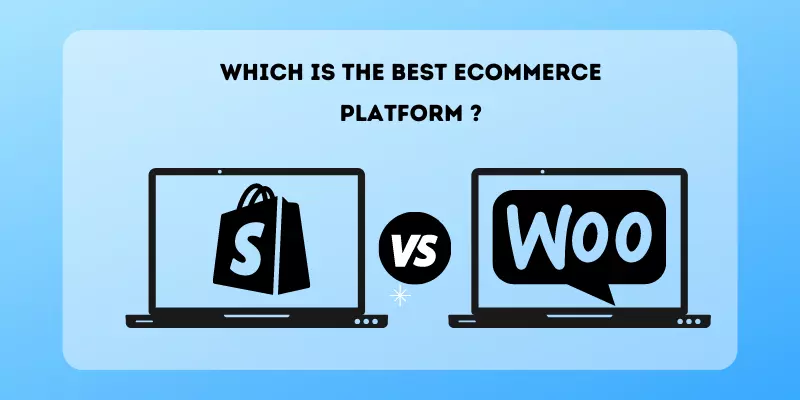
Quick Summary
Shopify and Woocommerce are well-known and famous E-commerce platforms, Below is a quick summary of both platforms.
Shopify
- Shopify provides a 14-day free trial
- Provides built-in hosting with unlimited storage
- Provides built-in hosting with unlimited storage
- 100+ themes (9+ free themes) and pricing ranges from ($180 – $350)
- BigCommerce has 6000+ apps
- BigCommerce has excellent support
WooCommerce
- WooCommerce is a free WordPress Plugin
- Open source platform without a hosting
- WooCommerce has 1000+ themes from third-party websites.
- WooCommerce provides extensive theme Customization
- WooCommerce has 10k+ Plugins Integrations
- WooCommerce doesn’t have good support
#7 Main Differences
1. Ease of Use
Shopify is comparably easier to set up and manage than WooCommerce, Shopify is a ready-made platform with store-building features.
Winner: Shopify
2. Domain and Hosting
Shopify Includes inbuilt hosting and SSL certification. Whereas WooCommerce doesn’t come with hosting and SSL, you need to purchase reliable Managed WordPress/Woocommerce hosting such as Bluehost or Kinsta.
Winner: Shopify
3. Themes & Editor
WooCommerce offers only 3 free themes and plenty of paid themes, Whereas Shopify offers 13 free themes and lots of paid themes. You can also get third-party themes. For example – Shopify Themes, and Woocommerce themes.
Winner: Shopify
4. Cart Features:
WooCommerce is flexible, it’s a WordPress plugin whereas the Shopify lite feature costs $9/month to embed product cart features on other platforms.
Winner: WooCommerce
5. Pricing:
Shopify eCommerce plans range from $29-$299, Whereas WooCommerce is free but it needs hosting. Recommended hosting – Bluehost (starts from $3/month).
Winner: WooCommerce
6. Payments and Charges
Both Shopify and WooCommerce offer more than 70+ payment providers, but Shopify charges transactional charges on sales if customers used any other payment method than Shopify Payments. (Shopify payments are limited to a few countries.
Winner: WooCommerce
7. App store
Apps help in automation and adding new features to your store, Shopify has over 6000+ apps to assist in online business, Whereas WooCommerce too has around 6000+ apps. but Shopify has better apps in comparison to WooCommerce
Winner: Shopify
Ease of Use
Shopify platform is a beginner-friendly, Ready-made platform that can make the store go live on the Launch day itself. WooCommerce is not a beginner-friendly platform. Shopify is Beginner friendly, it lets you explore the basics of the eCommerce World. With its Excellent Reporting and Analytics features, one Can Understand customer and marketing behavior. Shopify Takes care of your hosting and Security Concerns, so you can focus on growing your business.
It has fast setup time than WooCommerce. With zero coding knowledge, you can build a beautiful shop. There are lots of blogs and videos available to guide you on building a store.
It’s a very good platform for Unique Projects and gives you the freedom of customization. If you have already worked on WordPress you can set up shop easily.
Hosting & Security
| Shopify | WooCommerce | |
| Inbuilt Hosting | ✔ | ❌ |
| Domain Provides | ✔ | ❌ |
| Storage & Bandwidth | Unlimited | ❌ |
Shopify website builder provides inbuilt hosting. All the security concerns, and hosting maintenance will be taken care of by Shopify. WooCommerce is an open-source plugin that can be easily installed on WordPress. It doesn’t provide hosting so users need to do extra hustle to buy and set up manual hosting.
Shopify takes full responsibility for your store security, Data backup, and speed time. No matter how big your business is, it operates smoothly and Fast on its server. Shopify security follows all 6 PCI standards and it has built-in fraud protection to protect your site from threats. While in the case of WooCommerce performance of site speed, Data backup, and security all Depend upon the Server website is hosted, if any server Issues occur users need to resolve them themselves.
Themes & Customization
| Shopify | WooCommerce | |
| Themes | 80+ | 1k+ |
| Free Themes | 10+ | 100+ |
| Mobile-Friendly | Yes | Yes |
| Theme Customization level | Basic | Very Good |
| Prebuilt Sections | No | No |
Shopify’s Theme Store has Several Free and Paid Themes for all kinds of businesses. WooCommerce also has free and paid themes. With WooCommerce users will never run out of choice of themes. Users can Import themes from third-party sites like ThemeForest, and Templateforest and integrate them with the store.
Shopify’s user-friendly Theme Editor allows you to Customize and design your store faster. You can try out various themes and design layouts for your store and choose one which fits your requirement. WooCommerce allows you to Customize & design Store Extensively. The WooCommerce user With good Knowledge of coding and Custom CSS Can Build their Dream Store.
Shopify themes

Pricing & Plans
| Shopify | WooCommerce | |
| Trial period | 14 days | No trial period |
| Starting price | $29.9/mo | $2.95/mo (Bluehost) |
| eCommerce price | $29.9/mo – $299.9/mo | $9.95/mo (Bluehost e-commerce) |
| enterprise pricing | Custom Pricing | Custom Pricing |
Shopify has three Plans
Basic Shopify:$29/m($26)
Shopify:$79/m ($71)
Advance Shopify: $299/m ($269)
(Prices in the Bracket are applicable when you buy a year plan)
Shopify also imposes charges in the form of themes and third-party apps.
WooCommerce is free to install, but you need to pay for hosting, Security & SSL. WooCommerce provides free and paid plugins but some of the basic plugins are costly. Most of the plugins impose an annual plan. Some of the Plugins like Yoast SEO Cost 69/year. Marketing Channels plugins cost around $70/year.
Payment Options and Charges
| Shopify | WooCommerce | |
| Payment methods | 70+ | 70+ |
| Transaction charges | Transaction charges (2%,1%,0.5%) on sales value respectively on 3 plans for non Shopify payment users. | 2% for WooCommerce Payments |
| Credit Card Charges | ✔ | ✔ |
Shopify and WooCommerce Both provide Over 100 Payment Providers to support both Domestic and International Transactions. They Integrate with popular payment provider Stripe, Paypal, Square, etc.
—————-Charges association with Shopify and WooCommerce —————
Shopify’s own payment Method “Shopify payments” has zero Transaction Fees, but it’s only limited to some Countries. WooCommerce too has its own payment method called WooCommerce payment, which charges a processing fee of 2% on every transaction.
If the User uses other payment providers than Shopify payment it will Charge you a 2% Fee for Basic Plan. 1% for Plus & 0.5% for Advanced plan. WooCommerce doesn’t charge transaction charges on payment providers except for WooCommerce payments. Both platforms impose credit card charges for using payment providers for transactions.
SEO & Blogging
SEO is one of the main factors to Drive Traffic and Sales. Shopify provides a box-type layout on every product and collection with basic on-page SEO. Shopify is well optimized on the Technical SEO Side as the Site speed, crawling Speed effects, and Uptime are best at Shopify. WooCommerce is regarded to be good for SEO as it uses WordPress as CMR. It has lots of Rich Snippets and Plugins such as Yoast SEO which is a handy tool For on-page SEO.
Shopify Has a Blog Section, so you can write more content about your products, Collections, and build links with other Websites. WooCommerce contains an inbuilt WordPress blog Section that helps in writing the content about your products, Collections.
Marketing
Shopify and WooCommerce have plenty of marketing automation to help businesses grow.
——————————Email Marketing —————–——-
Both Shopify & WooCommerce users can access Email automation software like MailChimp, Klaviyo, Sendinblue, etc through their third-party integration. Shopify has its own built-in Shopify email software to provide email automation.
——————————Social Media—————–—–
Both Shopify and WooCommerce have plenty of social media automation apps. Shopify lets users to run ad campaigns directly from the Shopify dashboard. WooCommerce relies on third-party integration to provide these facilities.
——————————–MultiSale Channels ————-
Shopify provides direct integration with sales channels like Amazon, eBay, Etsy, etc to facilitate selling on these Channels. . It integrates with Social and Ecommerce Channels. Integration with Facebook, Google, and Pinterest is Free But the Integration with Amazon,eBay, and other Channels is Paid.
——————————-App Store—————————
Both Shopify and WooCommerce have provided plenty of third-party marketing apps which provide the following features.
- Subscription
- Affiliate te Marketing
- Discount Code
- Gift Card
- POS for Offline marketing
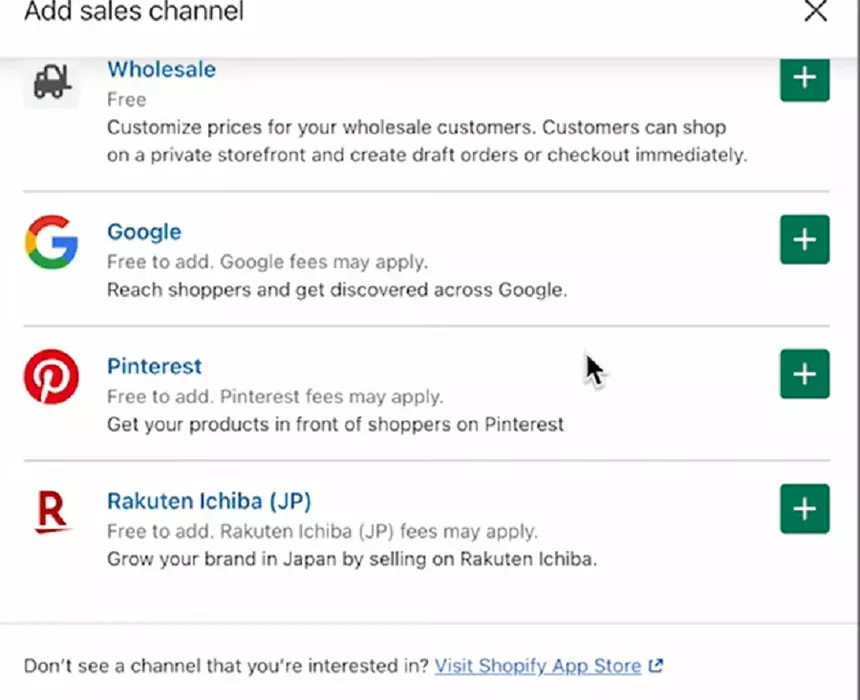
WooCommerce sales channel
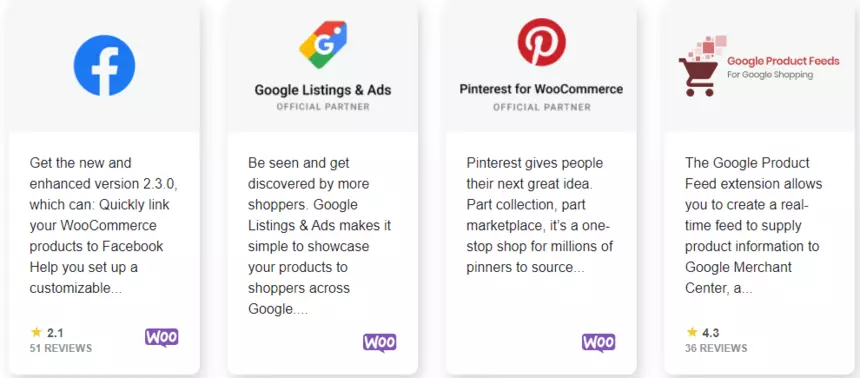
Analytics & Reports
Shopify has an analytics section to provide various reports and stats. Shopify has a live view to track real-time customer behavior. Shopify gives statistical insights around the most bought, most searched, and returning customers’ rates. There are plenty of reports shopify provides like Acquisition, Inventory, Marketing, Order, and Sales reports. Shopify’s live view enables users to track the real-time behaviors of visitors.
WooCommerce does provide a basic dashboard that enables you to track sales, inventory, orders, Manage taxes, etc. WooCommerce doesn’t Provide Live Reporting and the data around customer behavior & By connecting your store to google analytics you can access the data around customers.
Shopify Analytics
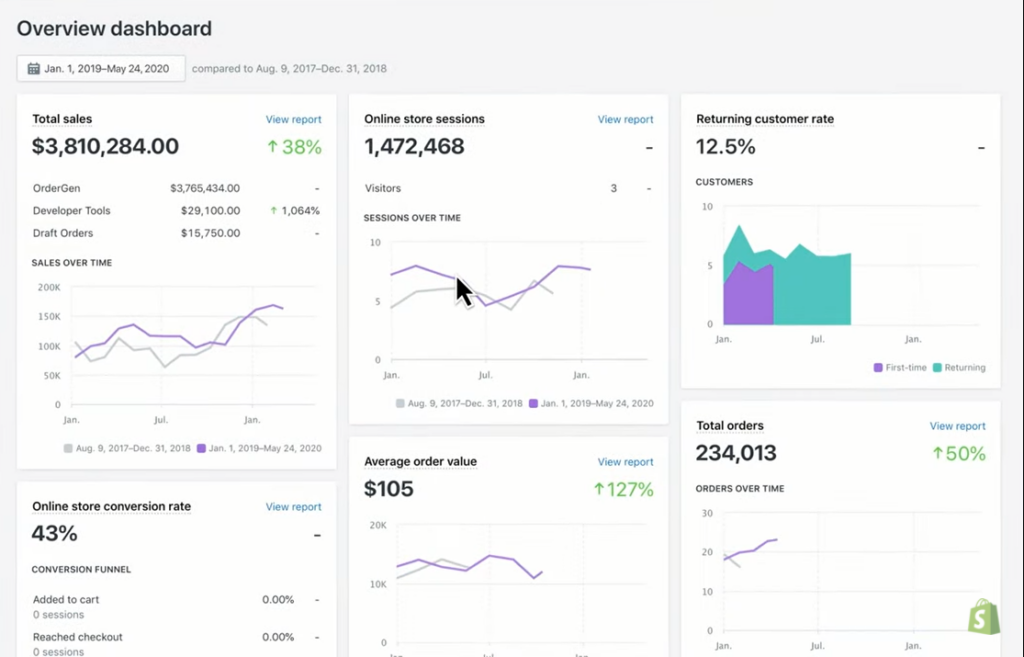
WooCommerce reports
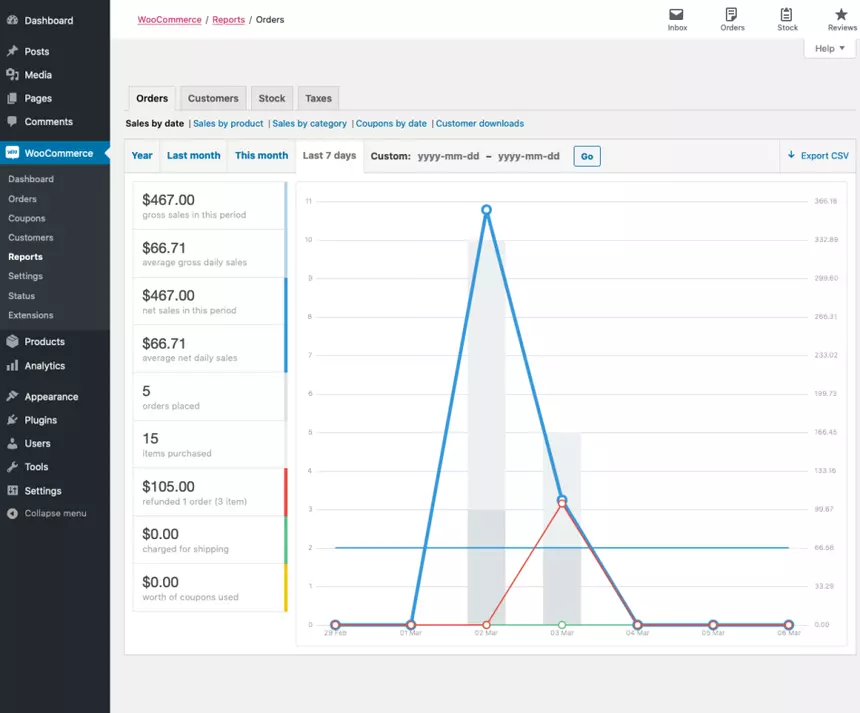
Scalability
Both Shopify & WooCommerce provide huge scalability options. They are capable of hosting all kinds of businesses. Users can take small or medium size businesses to enterprise businesses. Shopify’s Advanced and Plus plan features help you in achieving infinite scalability. Shopify has Lots of tools available in the app store to automate Marketing, Customer service, and Shipping. WooCommerce provides control of changing Structure and Branding as per the requirement keeping it ahead of Shopify. Shopify app store has way more Plugins than WooCommerce to Automate Repeating workflows.
Customer Support
| Shopify | WooCommerce | |
| ✔ | ✔ | |
| Live chat | ✔ | ❌ |
| Phone | ✔ | ❌ |
Shopify has the Best Support team, It’s Available 24*7. They help you through Live Chat and email support. Shopify has an Active Community where your Queries will be solved. As Woocommerce is a plugin any issue arises on the platform you have to contact their Support team by creating an account there. Alternatively, you need to contact the hosting provider if an issue lies on their side
As Woocommerce is a plugin any issue arises on the platform you have to contact their Support team by creating an account there. Alternatively, you need to contact the hosting provider if an issue lies at their side
There are plenty of Shopify Blogs and videos available on the internet to guide you. Shopify’s Support team even Solves the issue that occurred through the third-party app. If they don’t solve them immediately they follow up With an email once they have a solution. WooCommerce has plenty of support systems in form of blogs, articles, videos, forums, etc. WooCommerce third-party apps provide plenty of services.
Shopify Support
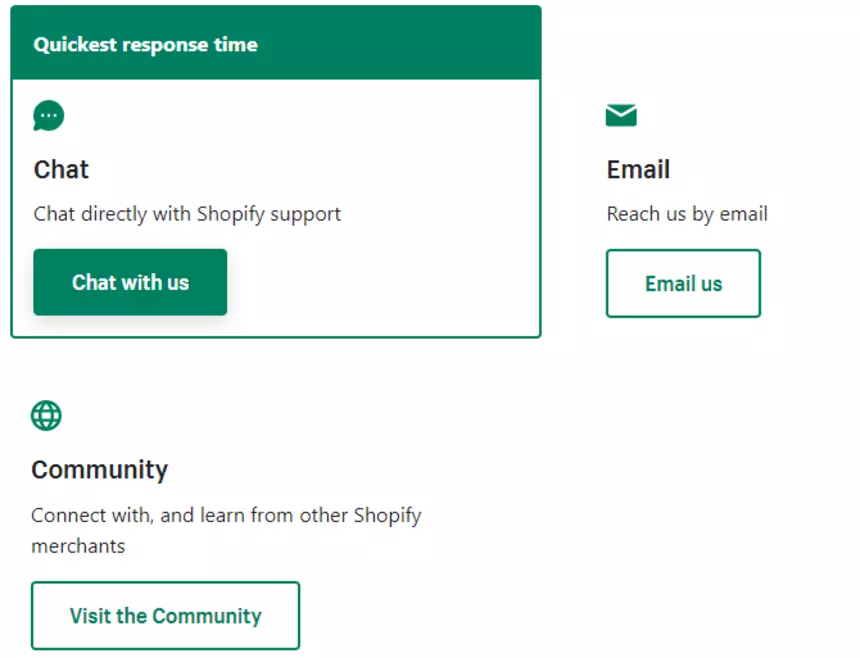
WooCommerce Support
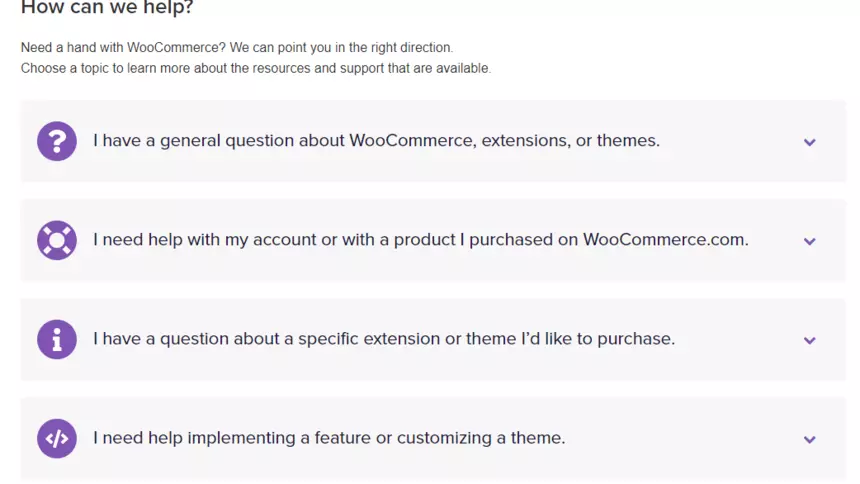
FAQ: Shopify Vs WooCommerce
Ecommerce Platforms Market Share
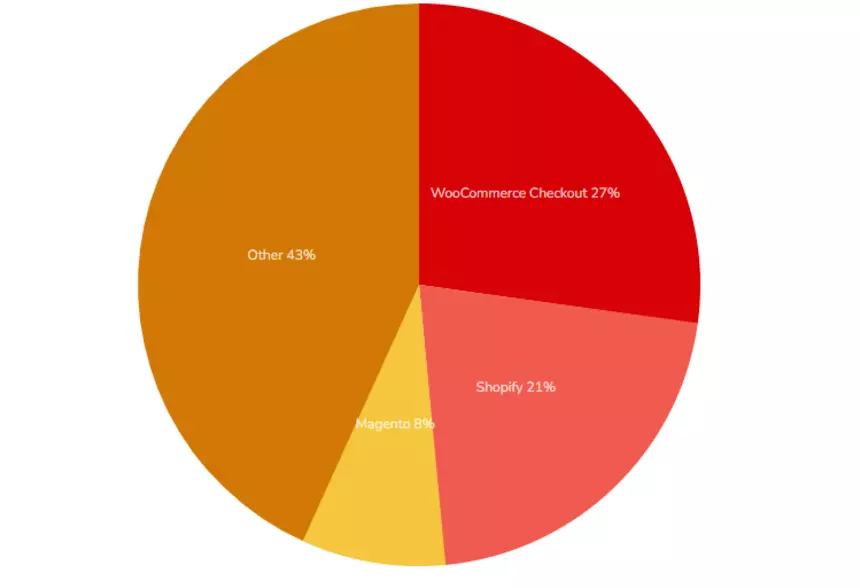
By Market Share, WooCommerce is Ahead of Shopify. Shopify has Over 3.6M+ Websites all Over the World. it has been Extensively Used in Tier 1 Countries Such as the USA, Cannada, Australia, etc. Whereas WooCommerce hosts over 5.6M+ Websites all over Word.

WooCommerce and Shopify hold 3.49% & 2.73% respectively of the Top 1M+ Websites in the World.
Ecommerce success story : Shopify vs WooCommerce
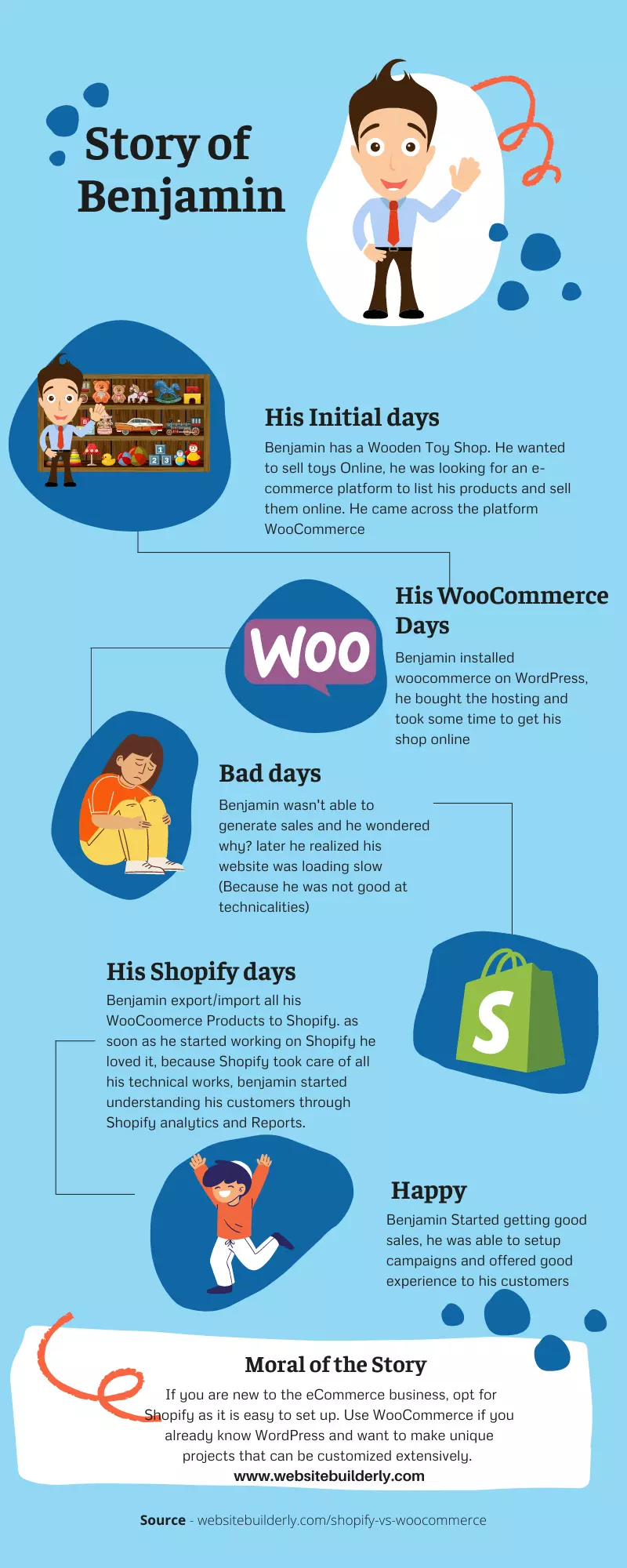
Top Shopify websites






Top WooCommerce websites






Pros and Cons: Shopify vs WooCommerce
| Shopify Pros | Shopify Cons |
| 1. Inbuilt hosting and security | 1. Transaction fees on each sale |
| 2. Beginner Friendly | 2. Costly plans |
| 3. Live view & Advance Reporting | 3. Paid apps are expensive |
| 4. Easy to set up and manage | 4. limitation in Customization of themes |
| WooCommerce Pros | WooCommerce Cons |
| 1. No store transaction fees | 1. No inbuilt hosting |
| 2. Developer-friendly | 2. Basic Analytics & Reports |
| 3. Free to install | 3. Most of the Extensions are billed annually |
| 4. Endless Customization | 4. Not so beginner-friendly. |
Conclusion: Shopify vs WooCommerce:
Use Shopify over Woocommerce,
- If you want a platform to take care of your store’s hosting, maintenance, and security concerns. Then Shopify is best for you as it comes with inbuilt hosting & Security.
- If you are looking for an easy-to-setup and manage business platform then Shopify is better than WooCoomerce.
- If you are planning to do dropshipping business then Shopify is for you, as it has more integration than WooCommerce with Global suppliers and shipment companies.
- If you want 24/7 support, a handful of store automation, and more payment options for your business then Shopify is better than woo commerce.
Use Woocommerce Over Shopify,
- If you want 100% flexibility in stores Customization, design, and structure then Woocomerce is more convenient than Shopify
- If you are looking to write more content about your eCommerce store then Woocommerce is better than Shopify as it has better CMS features than Shopify.
- If you are looking for a Free platform with good e-commerce functions then woo commerce is better than Shopify,
- If you want more templates, inbuilt features, and SEO features then woo-commerce is better than Shopify.
Jack is the Co-founder of WebsitebuilderLy, a Software Engineer from Standford University, An entrepreneur with 12 years of Website Creation, Management, Marketing Automation & App Development Experience. Worked for the world’s leading companies such as Roblox, HTC, etc.
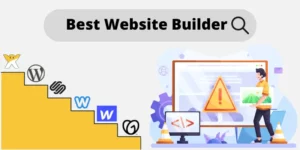





![How To Make A Website? 3 Different Ways Showed With Step By Step For Beginners. Choose The One You Liked [2024] How To Make A Website - 3 Different Ways](https://websitebuilderly.com/wp-content/uploads/How-To-Make-A-Website-3-Different-Ways-300x150.webp)

